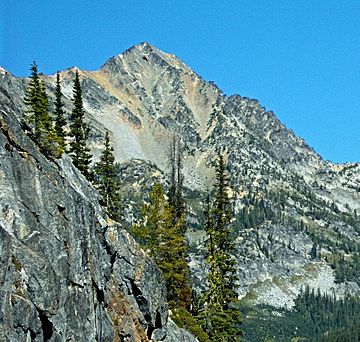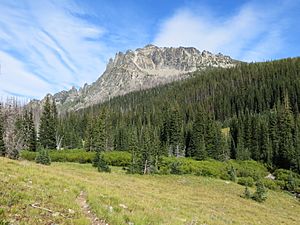Saska Peak facts for kids
Quick facts for kids Saska Peak |
|
|---|---|

Saska Peak, south aspect
|
|
| Highest point | |
| Elevation | 8,404 ft (2,562 m) |
| Prominence | 644 ft (196 m) |
| Isolation | 0.65 mi (1.05 km) |
| Parent peak | Emerald Peak 8,422 ft |
| Geography | |
| Location | Chelan County Washington, U.S. |
| Parent range | Chelan Mountains North Cascades Cascade Range |
| Topo map | USGS Saska Peak |
| Type of rock | hornblende quartz diorite, granodiorite |
| Climbing | |
| Easiest route | class 3 scrambling South ridge |
Saska Peak is a tall mountain in Washington state. It stands 8,404 ft (2,560 m) high in the Chelan Mountains. This peak is located in Chelan County.
Saska Peak is part of the Glacier Peak Wilderness area. It is also within the North Cascades mountain range. The land around it is managed by the Wenatchee National Forest. Saska Peak is the third-highest peak in the Chelan Mountains. It is also the 74th-highest mountain in all of Washington state.
The closest taller mountain is Emerald Peak. It is about 0.66 mi (1.06 km) to the east-northeast. Another nearby peak is Cardinal Peak, about 1.52 mi (2.45 km) to the east-southeast. These three high peaks surround the start of the North Fork Entiat River valley. Water from the peak flows into the Entiat River.
The mountain was named after Shil-how-Saskt, a leader of the Entiat people. The name was given by Albert Hale Sylvester, a surveyor who named many places in the Cascades. In the Columbia-Moses language, "Saska" means "Standing in the middle of the sky."
Weather at Saska Peak
Most of the weather in this area comes from the Pacific Ocean. These weather systems move northeast towards the Cascade Range. When they reach the North Cascades, the tall mountains force the air upward. This causes the air to cool and drop its moisture. This means a lot of rain or snow falls on the Cascades. This process is called Orographic lift.
Because of this, the North Cascades get a lot of precipitation. This is especially true in winter, when most of it falls as snow. Winters are usually cloudy. However, in summer, high-pressure systems over the Pacific Ocean often bring clear skies.
How Saska Peak Was Formed
Saska Peak is made mostly of two types of rock: granodiorite and hornblende quartz diorite. These rocks are part of a large body of rock called the Cardinal Peak pluton. The North Cascades are known for their rugged landscape. They have sharp peaks, spires, ridges, and deep valleys carved by glaciers.
The mountains here were formed over millions of years. This process began in the late Eocene Epoch. The North American Plate slowly moved over the Pacific Plate. This movement caused many volcanic eruptions. Glacier Peak, a large volcano, started forming about 21.8 mi (35.1 km) west of Saska Peak.
Also, small pieces of the Earth's crust, called terranes, helped create the North Cascades. This happened about 50 million years ago. During the Pleistocene period, which was over two million years ago, glaciers moved across the land many times. As they moved, they scraped away rock and left behind debris. The "U"-shaped valleys you see today were carved by these glaciers. The combination of land being pushed up (orogeny) and cracks in the Earth's crust (faulting), along with glaciation, created the tall peaks and deep valleys of the North Cascades.
Images for kids






